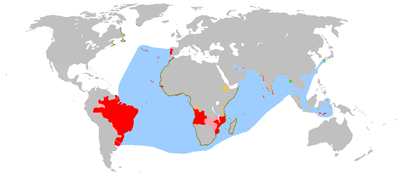State of Maranhão and Piauí
| State of Maranhão and Piauí | ||||||||||
| Estado do Maranhão e Piauí | ||||||||||
| State of the Portuguese Empire | ||||||||||
| ||||||||||
| ||||||||||
| Capital | São Luís | |||||||||
| Languages | Portuguese | |||||||||
| Religion | Roman Catholicism | |||||||||
| Government | Monarchy | |||||||||
| Monarch | ||||||||||
| • | 1772–1775 | Joseph I | ||||||||
| Governor General | ||||||||||
| • | 1772–1775 | Joaquim de Mello e Póvoas | ||||||||
| History | ||||||||||
| • | Established | 1772 | ||||||||
| • | Disestablished | 1775 | ||||||||
| Currency | Portuguese Real | |||||||||
| ||||||||||
The State of Maranhão and Piauí (Portuguese: Estado do Maranhão e Piauí) was one of the states of the Portuguese Empire.
History
The state was created in 1772 by order of Sebastião José de Carvalho e Melo, 1st Marquis of Pombal, the Secretary of the State for Joseph I of Portugal.[1]
The state was created because of the economic success of the State of Grão-Pará and Maranhão. Sebastião José de Carvalho e Melo split that state into two states, the State of Grão-Pará and Rio Negro and the State of Maranhão and Piauí, thinking that this would cause even better economic conditions, though the state split would prove a failure.
In 1775, due to the failure of the new state, both the State of Grão-Pará and Rio Negro and the State of Maranhão and Piauí were merged into the State of Brazil, finally unifying Portuguese America into one colony.
.svg.png)
.svg.png)
